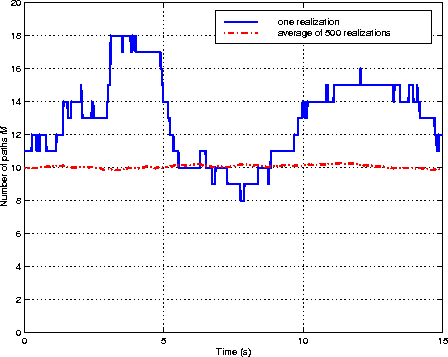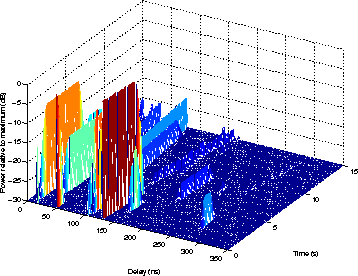
 | Wireless CommunicationChapter: Wireless Propagation Channels |
Different important effects giving rise to long-term fluctuations have been implemented in the SRCM :
The simulation of path loss is based on the extended linear model as proposed in [5]:
where ![]() means the free-space loss at 1 m distance and d denotes the
distance between the transmitter station and the MT. A power decay
exponent of n=2 and a path attenuation of
means the free-space loss at 1 m distance and d denotes the
distance between the transmitter station and the MT. A power decay
exponent of n=2 and a path attenuation of ![]() reveal
to be in good agreement with experimental results.
reveal
to be in good agreement with experimental results.
Following [6] the locations along the trajectory where paths become active form a Poisson process with a certain occurrence rate. The length of the active segments is exponentially distributed.

Figure: Variation of the number of active paths
The number of active paths ![]() along
the trajectory is then a Poisson process with the mean
along
the trajectory is then a Poisson process with the mean
![]() . Figure 4
illustrates the variation of the number of dominant impinging waves.
. Figure 4
illustrates the variation of the number of dominant impinging waves.
The power variation of the multipath components in transition situations is simulated by means of smooth monotone functions as suggested similarly in [7] .
MT movement will also cause fluctuations of the delay and the incidence direction of the wave components. The location dependency is described in [2]. No model has been developed yet to characterize the spatial dependency of the varying incidence directions due to a lack of experimental data.

Figure: Long-term fluctuations of the power and
delay of the waves
Figure 5 shows the influence of a dynamic incidence constellation resulting in fluctuations of the power and delay of the waves.
For sake of completeness it should be mentioned that because of the simulation of the changing number of active paths as previously described the so-called shadowing usually represented by a lognormal process in classic channel models is inherently embodied in the SRCM.
Figure 6 presents this fact in form of a successive approximation of the target function (9).
Table: Parameter set for the WAND-SRCM at 5.2 GHz [2]
As an example, Table 3 shows the parameter set of the
SRCM developed for the European ACTS project AC085 WAND (Wireless
ATM Network Demonstrator) [2]. Obviously, the delay spread is
related to the room size while ![]() as well as
as well as ![]() and
and ![]() are determined by the complexity of the furniture and equipment and
their geometry, respectively.
are determined by the complexity of the furniture and equipment and
their geometry, respectively.
![]()